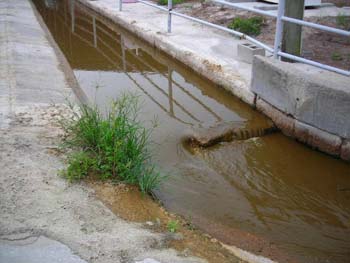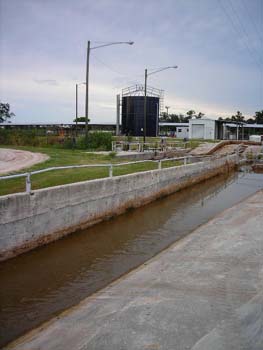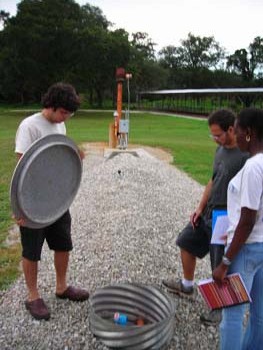Dairy Research Unit Field Trip

By: Patrick O'Donoughue
Following his three lectures on biogas and anaerobic digestion, Teaching Assistant James Duncan gave the interns a tour of the Diary Research Unit on Sunday July 29th. The Dairy Research Unit is located in Hague, FL roughly a thirty minute drive from the University of Florida campus. It is an operational dairy farm, with 500 to 600 cows on the property. With such a large number of cows, the manure represents a disposal issue. At the DRU they have set up a waste handling system that recovers the nutrients, fiber and energy contained in the manure.
 The tour followed the path of energy on the farm, starting with the food energy input to the cows. The Dairy Research Unit owns many acres of land surrounding the farm, which it utilizes to grow crops for food. All of the nourishment for the cows is grown in this manner with the exception alfafa, which is purchased from outside sources. The grains grown on the land are slightly processed and mixed with the alfalfa into forage for the cows. This mixture is then stored in large plastic bags from which the grains are drawn throughout the year.
The tour followed the path of energy on the farm, starting with the food energy input to the cows. The Dairy Research Unit owns many acres of land surrounding the farm, which it utilizes to grow crops for food. All of the nourishment for the cows is grown in this manner with the exception alfafa, which is purchased from outside sources. The grains grown on the land are slightly processed and mixed with the alfalfa into forage for the cows. This mixture is then stored in large plastic bags from which the grains are drawn throughout the year.
 The next step in the process is the consumption of food by the cows and the production of solid waste. The cows are kept in large open air barns with a sloping floor. The pens split the barn into three pieces, a central walkway, and two large pens on either side. The pens are lined with beds of sand for the cows to rest on, separated by elevation from a concrete grazing area. The forage is distributed in the central walkway along the edge of the pens. During warm days, the cows are kept cool with mist fans that
The next step in the process is the consumption of food by the cows and the production of solid waste. The cows are kept in large open air barns with a sloping floor. The pens split the barn into three pieces, a central walkway, and two large pens on either side. The pens are lined with beds of sand for the cows to rest on, separated by elevation from a concrete grazing area. The forage is distributed in the central walkway along the edge of the pens. During warm days, the cows are kept cool with mist fans that  spray the pen areas. Because of the set up of the pens the cows drop most of their solid waste onto the concrete grazing area not in the elevated sand beds. Coupled with the sloping floors, this allows the pens to be flushed with water daily to capture the waste.
spray the pen areas. Because of the set up of the pens the cows drop most of their solid waste onto the concrete grazing area not in the elevated sand beds. Coupled with the sloping floors, this allows the pens to be flushed with water daily to capture the waste.
The manure then travels downhill to a manure stream that runs from the pens to the anaerobic digester. The stream implements several methods of processing the  waste before it enters the anaerobic digester. The first method is velocity change in the stream as it travels over a slight drop off. This velocity change causes any sand from the beds to collect, where it can then be removed. The sand is recycled and deposited in the pens. The second processing technique is in the form of a mechanical press to remove any solids. Any solids in the manure represent fiber that could not be digested by the cows’ microbial cultures. Those
waste before it enters the anaerobic digester. The first method is velocity change in the stream as it travels over a slight drop off. This velocity change causes any sand from the beds to collect, where it can then be removed. The sand is recycled and deposited in the pens. The second processing technique is in the form of a mechanical press to remove any solids. Any solids in the manure represent fiber that could not be digested by the cows’ microbial cultures. Those  solids contain minimal energy and cannot be further digested by any culture. The captured fiber is then reapplied to the land where it helps prevent soil erosion, improves soil health, provides a biofilm for microbial growth, and returns some nutrients to the ground. After mechanical processing, the stream enters a system of weirs where any solids can further collect before the stream enters the anaerobic digester.
solids contain minimal energy and cannot be further digested by any culture. The captured fiber is then reapplied to the land where it helps prevent soil erosion, improves soil health, provides a biofilm for microbial growth, and returns some nutrients to the ground. After mechanical processing, the stream enters a system of weirs where any solids can further collect before the stream enters the anaerobic digester.
The anaerobic digester is very large, holding 100,000  gallons. The digester is also described by its low 3 day retention time and fixed film media. The fixed film resembles vertical PVC pipes where microbes coat the interior and exterior. Microbial cultures that grow on the film collaborate to improve efficiency which helps reduce the retention time. This highly productive metabolic state coupled with the removal of the solids in the influent helps reduce the sludge generation.
gallons. The digester is also described by its low 3 day retention time and fixed film media. The fixed film resembles vertical PVC pipes where microbes coat the interior and exterior. Microbial cultures that grow on the film collaborate to improve efficiency which helps reduce the retention time. This highly productive metabolic state coupled with the removal of the solids in the influent helps reduce the sludge generation.
 The results of anaerobic digestion are biogas, which is composed in this case of 80 to 90 percent methane, and a liquid effluent. The effluent is what’s left over after the microbial processes and contains mostly nutrients. The Dairy Research Unit applies the effluent as a fertilizer to the crop land. The biogas is the final product of the manure, capturing the energy that is contained in the waste. Unfortunately, it cannot be sold to the utility company, so the DRU uses it entirely on site. Currently, the gas is only used to heat water for various uses on the farm,
The results of anaerobic digestion are biogas, which is composed in this case of 80 to 90 percent methane, and a liquid effluent. The effluent is what’s left over after the microbial processes and contains mostly nutrients. The Dairy Research Unit applies the effluent as a fertilizer to the crop land. The biogas is the final product of the manure, capturing the energy that is contained in the waste. Unfortunately, it cannot be sold to the utility company, so the DRU uses it entirely on site. Currently, the gas is only used to heat water for various uses on the farm,  included the pasteurization of the milk. Any remaining biogas is flared.
included the pasteurization of the milk. Any remaining biogas is flared.
The biogas that is generated is a manifestation of the solar energy input to the plants that was not utilized by the cows and recovered in the waste. This waste treatment method utilizes a renewable energy source, while preserving soil health and limiting the environmental impact of a waste stream. Further, the farm benefits from reduced waste treatment costs and reduced utility costs.